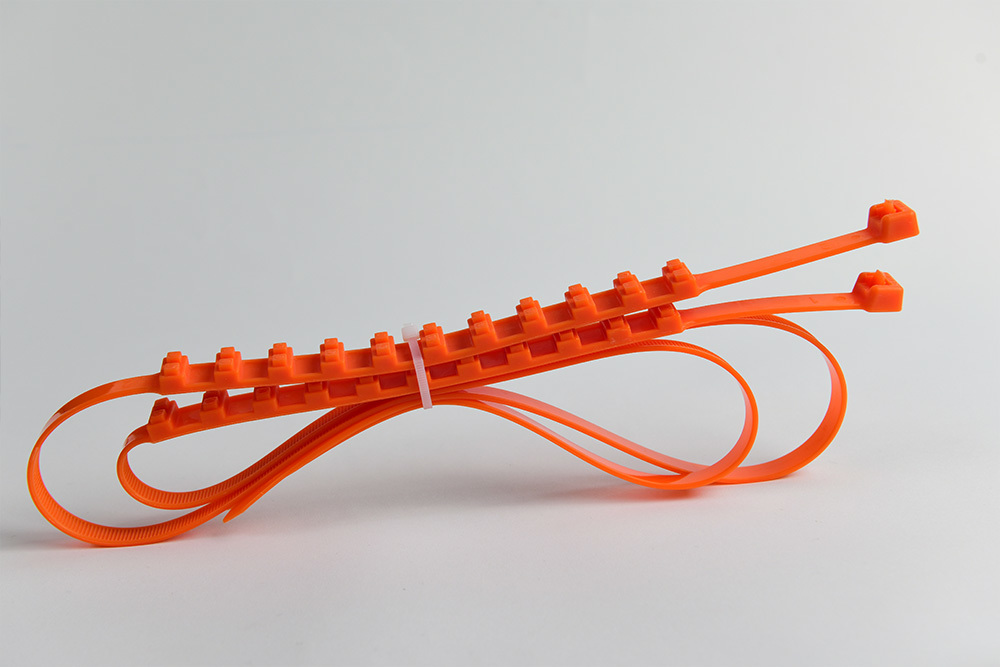17
2025
-
07
Precautions for using plastic cable ties at high temperatures
Author:
Key Considerations for Using Plastic Cable Ties in High-Temperature Environments
Plastic cable ties are widely used for securing and organizing items, but their performance can degrade under extreme heat. To ensure safety and functionality, users must account for material properties, environmental factors, and application-specific demands when operating in high-temperature settings.
Material Selection and Temperature Tolerance
The choice of material determines a cable tie’s ability to withstand heat without softening, deforming, or breaking:
- Standard Nylon 6/6: Most general-purpose ties made from this material tolerate temperatures up to 85°C (185°F) continuously. Beyond this threshold, they may lose tensile strength or become brittle.
- Heat-Stabilized Variants: Some manufacturers incorporate additives like heat stabilizers to enhance thermal resistance. These ties can endure temperatures up to 120°C (248°F) for prolonged periods, making them suitable for automotive engine compartments or industrial machinery.
- Specialized Polymers: For extreme conditions, ties crafted from high-performance polymers like polyphenylene sulfide (PPS) or polyether ether ketone (PEEK) resist temperatures exceeding 200°C (392°F). These are ideal for aerospace or chemical processing applications.
Always verify the manufacturer’s temperature rating for the specific tie model. Using ties rated below the ambient temperature risks premature failure, which could lead to equipment damage or safety hazards.
Environmental Factors Impacting Performance
High temperatures often coincide with other environmental stressors that compound the challenges for cable ties:
- UV Exposure: Prolonged sunlight accelerates polymer degradation, even in heat-resistant ties. In outdoor settings, such as solar panel installations, select ties with UV inhibitors to prevent embrittlement.
- Chemical Exposure: Certain chemicals, like oils or solvents, weaken polymer structures when heated. For example, a tie securing pipes in a chemical plant may fail faster if exposed to both heat and corrosive substances. Prioritize ties with chemical-resistant coatings in such environments.
- Humidity and Moisture: While high humidity alone rarely affects ties, condensation at elevated temperatures can create localized cooling, leading to thermal stress. In humid industrial settings, ensure ties are fully dried before installation to avoid uneven tension.
Conduct a site assessment to identify all environmental factors influencing tie performance. Combining heat resistance with other protective features ensures longevity.
Proper Installation Techniques for High-Heat Applications
Even heat-resistant ties can fail if installed incorrectly. Follow these guidelines to maximize reliability:
- Avoid Over-Tightening: Excessive force concentrates stress on the ratchet mechanism, increasing the likelihood of cracking under heat. Tighten ties until snug but leave a small gap (2–3 mm) between the bundle and the ratchet head to accommodate thermal expansion.
- Use Tensioning Tools: Manual tightening can lead to inconsistent pressure, especially in large-scale installations. Tools designed for high-temperature ties apply uniform force, reducing the risk of over-compression.
- Trim Excess Material Carefully: Cut the tail flush with the ratchet head using diagonal cutters to prevent sharp edges. In high-vibration environments, like HVAC systems, leave a 1–2 cm tail to avoid abrasion against nearby surfaces.
- Pair with Protective Sleeves: For ties securing cables near heat sources, such as exhaust systems, use silicone or fiberglass sleeves to insulate the bundle. This reduces direct heat transfer to the tie, extending its lifespan.
Regularly inspect installed ties for signs of deformation, such as warping or discoloration, which indicate thermal damage. Replace compromised ties immediately to maintain system integrity.
Monitoring and Maintenance in High-Temperature Settings
Continuous exposure to heat necessitates proactive maintenance to prevent unexpected failures:
- Schedule Inspections: In industrial facilities, inspect ties every 3–6 months, focusing on areas near furnaces, boilers, or motors. Look for cracks, loosening, or melting, which signal degradation.
- Replace Aging Ties: Even if ties appear intact, polymers degrade over time under heat. Implement a replacement cycle based on the manufacturer’s lifespan recommendations or environmental severity.
- Document Installation Conditions: Record the temperature, humidity, and chemical exposure levels during installation. This data helps predict tie longevity and optimize maintenance schedules.
By adhering to these practices, users can leverage plastic cable ties as reliable components in high-temperature applications, balancing cost-efficiency with performance demands.
plastic cable ties
Previous Page
Next Page
Previous Page
Next Page
Hot News
2025-07-18
Circular binding method with plastic cable ties
Plastic cable ties are versatile tools for creating secure loops around cylindrical or irregularly shaped items. Mastering circular binding ensures stability in applications ranging from organizing cables to securing hoses or tools.
2025-07-18
Hidden binding techniques for plastic cable ties
Plastic cable ties are widely used for securing items, but visible ties can disrupt aesthetics in design-focused projects or cluttered spaces. Mastering hidden绑扎 (binding) methods ensures functionality without compromising visual appeal.
2025-07-17
Quick binding steps for plastic cable ties
Plastic cable ties are essential for organizing cables, securing bundles, or fastening objects efficiently. Mastering quick绑扎 (binding) techniques ensures projects are completed faster while maintaining strength and reliability. Below are clear, actionable steps for rapid and effective use.
2025-07-17
Precautions for using plastic cable ties at high temperatures
Plastic cable ties are widely used for securing and organizing items, but their performance can degrade under extreme heat. To ensure safety and functionality, users must account for material properties, environmental factors, and application-specific demands when operating in high-temperature settings.

